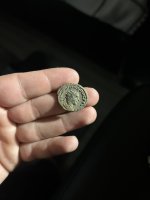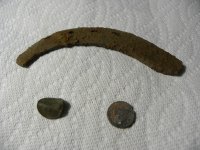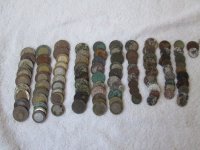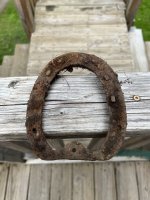- May 20, 2004
- 1,721
- 152
- Detector(s) used
- Minelab Excal 1000
- Primary Interest:
- All Treasure Hunting
BY DOUG TSURUOKA
INVESTOR'S BUSINESS DAILY
Posted 1/12/2007
An expedition using new software to search for the wreck of a ship commanded by Revolutionary War hero John Paul Jones found some interesting remains on the ocean floor off Britain — but the group isn't ready to declare victory.
Search team members hope the prow of one wreck found jutting from the sand in the North Sea off England's east coast are the remains of the Bon Homme Richard, the ship Jones used to defeat the British frigate HMS Serapis in an epic sea fight on Sept. 23, 1779.
The effort to find the Bon Homme Richard was first reported in IBD on June 26.
Navy Historical Unit Involved
"There's one wreck we especially like. It looks the way the Bon Homme Richard might look if we saw it on sonar," said Melissa Ryan, the project manager for the expedition.
The project is sponsored by the nonprofit Ocean Technology Foundation in Groton, Conn., and the U.S. Navy's Naval Historical Center (NHC) in Washington, D.C.
The ship was so badly shot up in the engagement that it sank after the battle, prompting Jones to move his crew to the captured British ship.
Jones' ship drifted for 36 hours before it slipped under the waves.
The battle between the ships took place off a promontory called Flamborough Head and was seen by hundreds of people on shore.
The search is drawing scientific interest because it's using special software that creates a drift simulation model. It incorporates tidal, wind and historical data from the day the battle was fought to pinpoint where the ship lies.
Rick Fernandes, a naval graphics expert, says it's the first time such software is being used to search for an 18th century shipwreck.
The software was developed by privately held Applied Science Associates of Narragansett, R.I., a marine science consulting firm that develops software for underwater uses.
The expedition hired a special research vessel and braved high seas. It lost about 12 days of search time last summer due to bad weather and called off the hunt in late September. While the wreck that just might be the Bon Homme Richard actually was found in late summer, the team didn't reveal the finding until last month.
The team plans to resume its quest this summer. Ryan says this time, the expedition will send a remotely operated underwater vehicle, or ROV, to probe the site. The ocean is about 175 feet deep at the site.
Critical to the hunt will be confirming whether the wreck contains large amounts of iron ballast. The Bon Homme Richard was known to be carrying large quantities of such ballast in its bottom when it sank.
Magnetometers, used to measure the strength and direction of magnetic fields, and other high-tech devices will be used to test for the presence of iron on the ocean floor, Ryan says.
The expedition also hopes to identify the vessel through the French-made cannon and personal effects of the crew that might be found amid the debris.
Need To Raise Money
If the wreck is the Bon Homme Richard, it will be a major historical find.
Jones' surprise victory over the Serapis was a factor that convinced France to join the U.S. in the Revolutionary War against Britain.
The Ocean Technology Foundation needs to raise about $250,000 in public contributions to fund next summer's effort. More information on the expedition can be found at bonhommerichard.org, a Web site set up by the OTF and NHC.
Colin White, director of the Royal Naval Museum in Portsmouth, Britain, hopes that the remains of the Bon Homme Richard can be found. But he warns that it won't be easy.
"There are a lot of wrecks out there (near Flamborough Head)," he said on a recent visit to New York City.
Ryan herself is cautious. "The wreck we're interested in might be too well-preserved to be the Bon Homme Richard," Ryan said.
At the same time, it just might be the well-preserved timbers of the ship they're looking for.
"The (bottom of the) North Sea is a very dynamic environment," she said. "Sands can shift and reveal things and just as easily cover them up."
http://www.investors.com/editorial/IBDArticles.asp?artsec=17&artnum=3&issue=20070112
INVESTOR'S BUSINESS DAILY
Posted 1/12/2007
An expedition using new software to search for the wreck of a ship commanded by Revolutionary War hero John Paul Jones found some interesting remains on the ocean floor off Britain — but the group isn't ready to declare victory.
Search team members hope the prow of one wreck found jutting from the sand in the North Sea off England's east coast are the remains of the Bon Homme Richard, the ship Jones used to defeat the British frigate HMS Serapis in an epic sea fight on Sept. 23, 1779.
The effort to find the Bon Homme Richard was first reported in IBD on June 26.
Navy Historical Unit Involved
"There's one wreck we especially like. It looks the way the Bon Homme Richard might look if we saw it on sonar," said Melissa Ryan, the project manager for the expedition.
The project is sponsored by the nonprofit Ocean Technology Foundation in Groton, Conn., and the U.S. Navy's Naval Historical Center (NHC) in Washington, D.C.
The ship was so badly shot up in the engagement that it sank after the battle, prompting Jones to move his crew to the captured British ship.
Jones' ship drifted for 36 hours before it slipped under the waves.
The battle between the ships took place off a promontory called Flamborough Head and was seen by hundreds of people on shore.
The search is drawing scientific interest because it's using special software that creates a drift simulation model. It incorporates tidal, wind and historical data from the day the battle was fought to pinpoint where the ship lies.
Rick Fernandes, a naval graphics expert, says it's the first time such software is being used to search for an 18th century shipwreck.
The software was developed by privately held Applied Science Associates of Narragansett, R.I., a marine science consulting firm that develops software for underwater uses.
The expedition hired a special research vessel and braved high seas. It lost about 12 days of search time last summer due to bad weather and called off the hunt in late September. While the wreck that just might be the Bon Homme Richard actually was found in late summer, the team didn't reveal the finding until last month.
The team plans to resume its quest this summer. Ryan says this time, the expedition will send a remotely operated underwater vehicle, or ROV, to probe the site. The ocean is about 175 feet deep at the site.
Critical to the hunt will be confirming whether the wreck contains large amounts of iron ballast. The Bon Homme Richard was known to be carrying large quantities of such ballast in its bottom when it sank.
Magnetometers, used to measure the strength and direction of magnetic fields, and other high-tech devices will be used to test for the presence of iron on the ocean floor, Ryan says.
The expedition also hopes to identify the vessel through the French-made cannon and personal effects of the crew that might be found amid the debris.
Need To Raise Money
If the wreck is the Bon Homme Richard, it will be a major historical find.
Jones' surprise victory over the Serapis was a factor that convinced France to join the U.S. in the Revolutionary War against Britain.
The Ocean Technology Foundation needs to raise about $250,000 in public contributions to fund next summer's effort. More information on the expedition can be found at bonhommerichard.org, a Web site set up by the OTF and NHC.
Colin White, director of the Royal Naval Museum in Portsmouth, Britain, hopes that the remains of the Bon Homme Richard can be found. But he warns that it won't be easy.
"There are a lot of wrecks out there (near Flamborough Head)," he said on a recent visit to New York City.
Ryan herself is cautious. "The wreck we're interested in might be too well-preserved to be the Bon Homme Richard," Ryan said.
At the same time, it just might be the well-preserved timbers of the ship they're looking for.
"The (bottom of the) North Sea is a very dynamic environment," she said. "Sands can shift and reveal things and just as easily cover them up."
http://www.investors.com/editorial/IBDArticles.asp?artsec=17&artnum=3&issue=20070112









